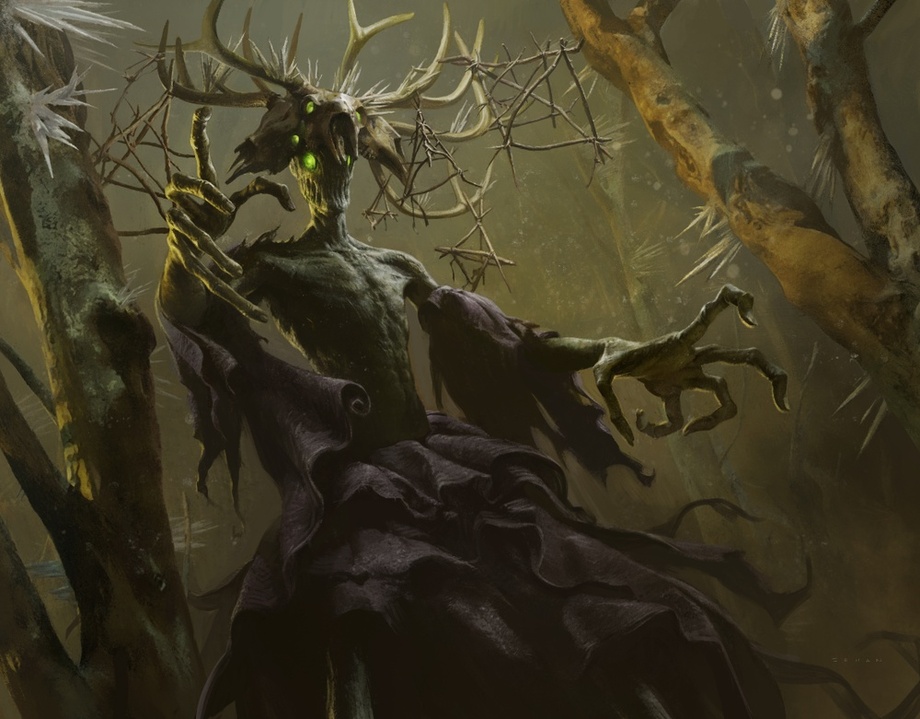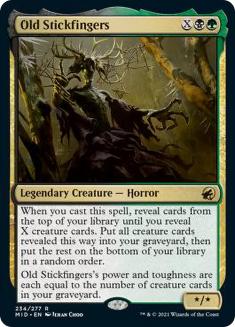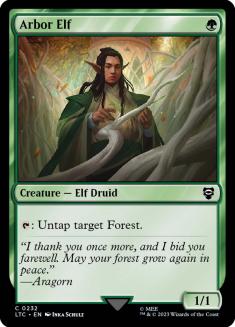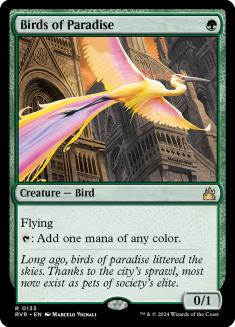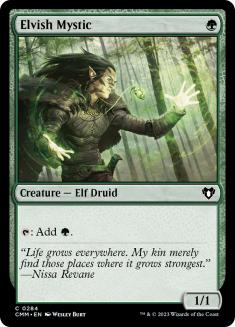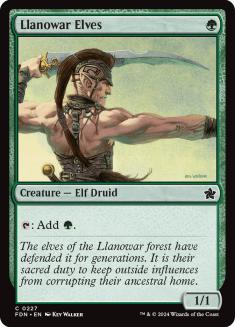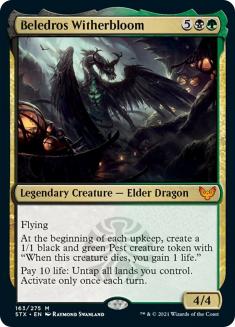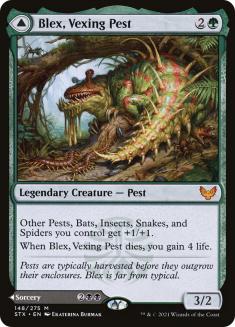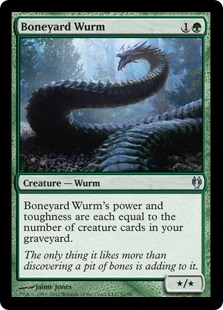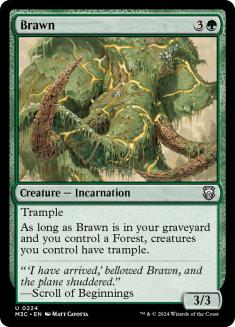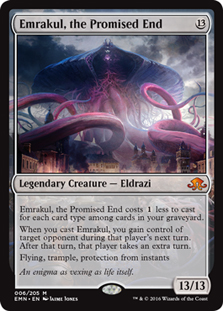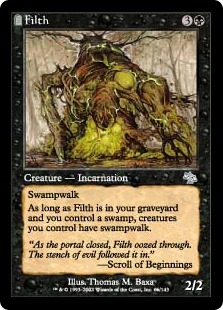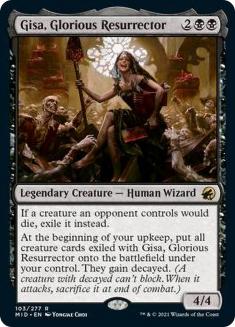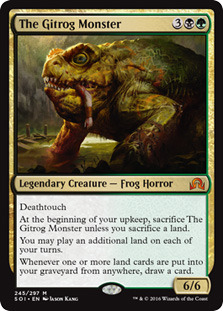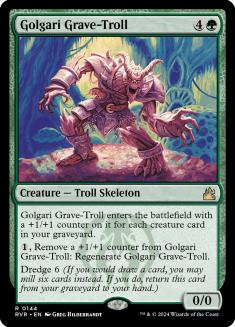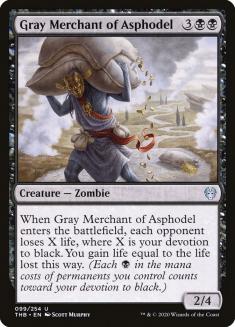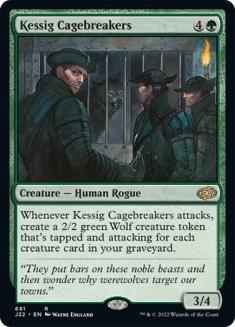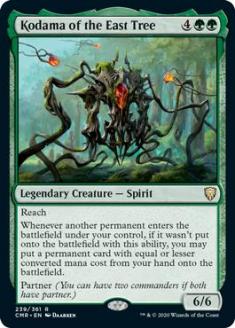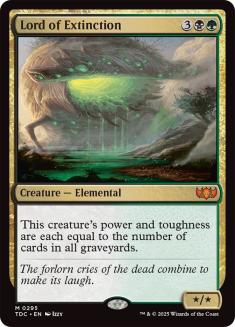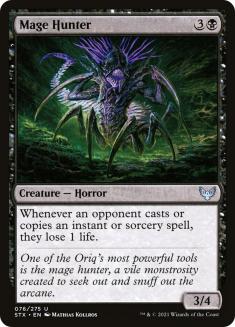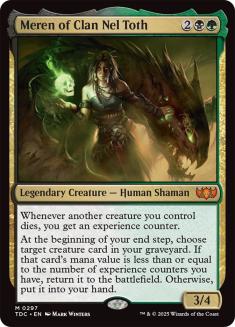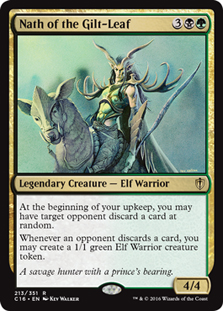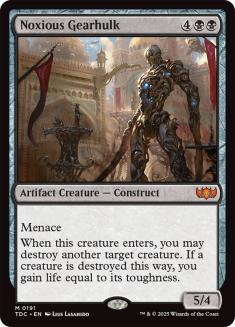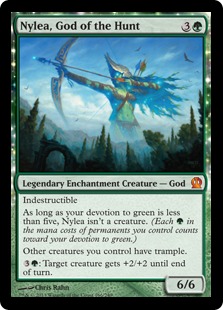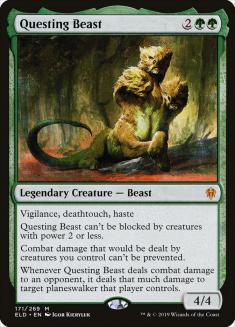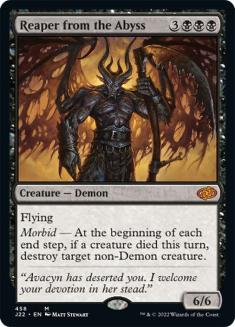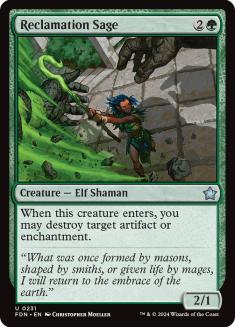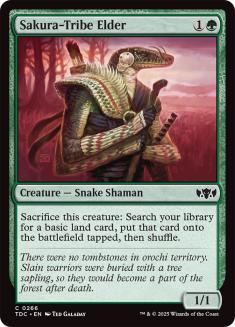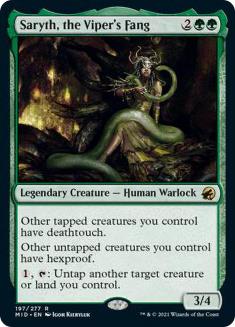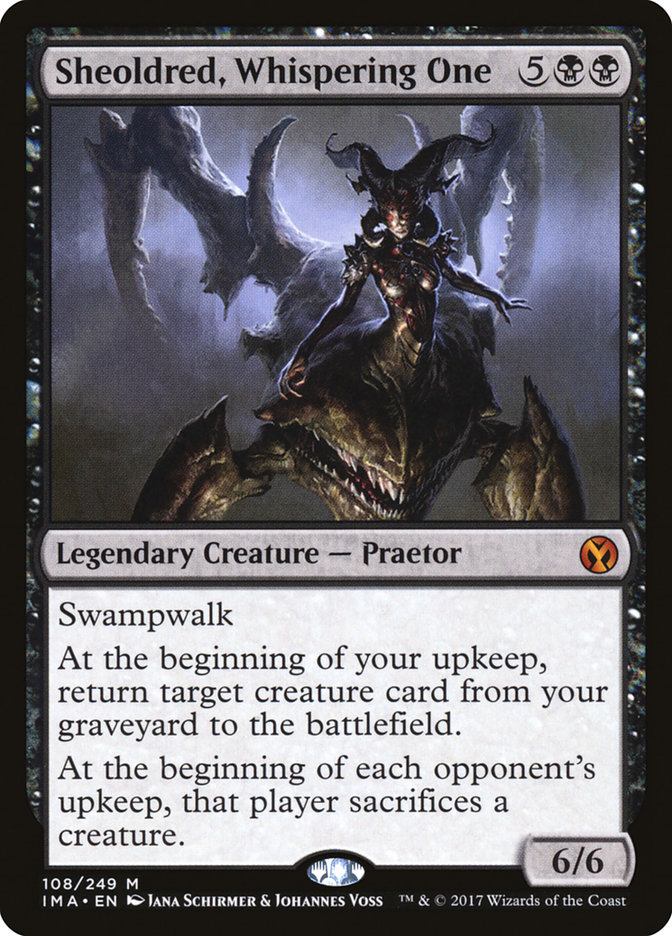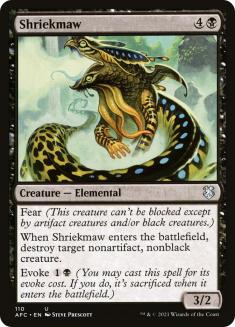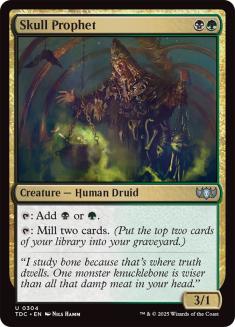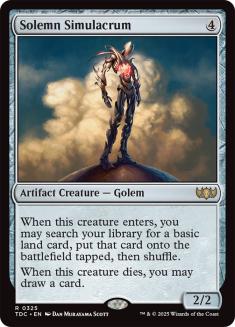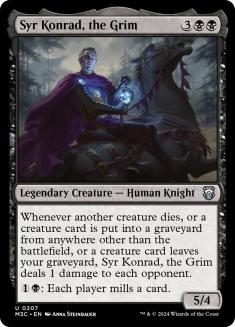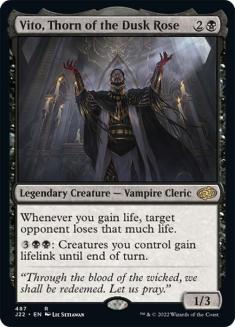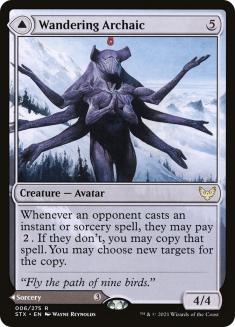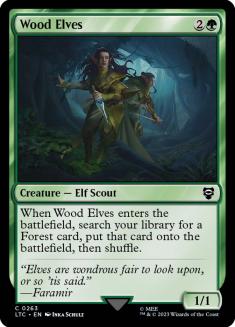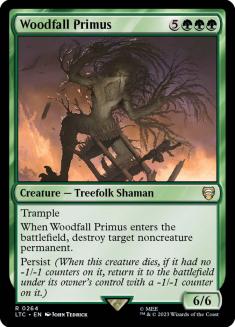When it came to building a deck out of one of the new Innistrad: Midnight Hunt commanders, I had a saucy initial idea. Liesa, Forgotten Archangel was the one that most excited me, so I started drawing it up. Then a funny thing happened on the way to the forum: everything started to seem familiar. Card choices and synergies offered an intense sense of déjà vu. Then somewhere around jamming in Inkshield, I realized why: the most recent normal Commander deck I built was Breena Will Do It To You. It was back into the design studio.
Fortunately, more than one legendary creature had my attention. Old Stickfingers scratched several itches. It does graveyard stuff, which is right up my alley. It also provides me with the opportunity to play a Golgari deck that’s not as grindy as my Glissa’s Artifacts deck. That Breena, the Demagogue deck relies on a kind of inevitability; I wanted something that was more active and aggressive.
I didn’t want to go down any obvious lines, so Zombies went right out the window, as that’s a theme in the Midnight Hunt Commander deck. I’m mostly meh on dredge as a mechanic, but I didn’t toss it completely out the window. Then it struck me that because I had focused so much on Silverquill during Strixhaven design, I hadn’t played as much with any of the other cards. There are plenty of Witherbloom cards that look fun and compelling, and I really hadn’t had a chance to sling many of them. While I didn’t really go down the Witherbloom line, I cherry-picked some neat cards along the way.
Eventually, I went with a creature-heavy deck that relies on milling things into the graveyard, mostly with Old Stickfingers, then reanimating for value. There are a few bulky creatures in there to do just that with, although there aren’t any Entomb effects that would really push the deck’s speed ratio into something that’s outside of my group’s comfort zone. Here’s the list, named Oldest Stickfingers because it has some OG cards in it:
Creatures (37)
- 1 Sakura-Tribe Elder
- 1 Llanowar Elves
- 1 Solemn Simulacrum
- 1 Birds of Paradise
- 1 Wood Elves
- 1 Filth
- 1 Brawn
- 1 Golgari Grave-Troll
- 1 Nath of the Gilt-Leaf
- 1 Shriekmaw
- 1 Woodfall Primus
- 1 Lord of Extinction
- 1 Arbor Elf
- 1 Sheoldred, Whispering One
- 1 Reaper from the Abyss
- 1 Boneyard Wurm
- 1 Kessig Cagebreakers
- 1 Splinterfright
- 1 Elvish Mystic
- 1 Nylea, God of the Hunt
- 1 Gray Merchant of Asphodel
- 1 Reclamation Sage
- 1 Meren of Clan Nel Toth
- 1 The Gitrog Monster
- 1 Emrakul, the Promised End
- 1 Noxious Gearhulk
- 1 Syr Konrad, the Grim
- 1 Questing Beast
- 1 Skull Prophet
- 1 Vito, Thorn of the Dusk Rose
- 1 Kodama of the East Tree
- 1 Wandering Archaic
- 1 Mage Hunter
- 1 Beledros Witherbloom
- 1 Blex, Vexing Pest
- 1 Gisa, Glorious Resurrector
- 1 Saryth, the Viper's Fang
Planeswalkers (1)
Lands (37)
Spells (24)
- 1 Reanimate
- 1 Living Death
- 1 Animate Dead
- 1 Fellwar Stone
- 1 Necromancy
- 1 Exhume
- 1 Oversold Cemetery
- 1 Decree of Pain
- 1 Victimize
- 1 Greater Good
- 1 Makeshift Mannequin
- 1 Momentous Fall
- 1 Exquisite Blood
- 1 Palace Siege
- 1 Arachnogenesis
- 1 Arcane Signet
- 1 The Great Henge
- 1 Tend the Pests
- 1 Mortality Spear
- 1 Rushed Rebirth
- 1 Liquimetal Torque
- 1 Unnatural Growth
- 1 Mask of Griselbrand
- 1 The Meathook Massacre

The deck relies on creatures to do nearly all the heavy lifting, from mana acceleration (Arbor Elf, Llanowar Elves, Wood Elves) to spot removal (Reclamation Sage, Noxious Gearhulk, Woodfall Primus). This obviously creates a vulnerability; one Humility would likely wreck my day. To some extent, that’s a metagame choice; it’s unlikely that the people I play with regularly (the rest of the Commander Rules Committee while we’re still on webcam, my local friends when things loosen back up) are dropping the card into their decks.
I feel like I’m reasonably safe in my trusted environment. If I were to venture outside of it, like maybe going to SCG CON (which I’m quite sad to be missing), I’d have to preface playing the deck with everyone understanding its limitations. We all generally want good games when we sit down, regardless of where we might be on the power level spectrum, so I simply wouldn’t want to play a deck that’s not a good fit. There are definitely games this one wouldn’t fit into. Fortunately, I have other decks to play.
Because the creatures are the feature of the deck, I’ll break down what I see as the role of each of them. In general, we’ll want to cast Old Stickfingers as early as possible for three or four just to get some creatures into the graveyard. Alongside that, we’ll want to get some of those strong mid-mana creatures, like Questing Beast, out and battling, putting pressure on life totals right away.
The mana acceleration quartet are there to get things going a bit faster. Turn 4 Old Stickfingers for three is where I’d like to be. Without other compelling action, I wouldn’t wait the extra turn to do it for four.
A prime reanimation target, Beledros will make some Pests, which can serve a few functions. Primarily, they’re chump blockers and something to sacrifice to Victimize.
A holdover from the Witherbloom draft, Blex, Vexing Pest still has value. With Beledros creating Pests or after a big Arachnogenesis there’s a payoff, but I’m fine with a 3/2 for three that gains us some life when it dies. What’s really neat about the card is the back side, Search for Blex. It will mill creatures and put other things into our hand. Then, when the card goes to the graveyard, the front face—namely a creature card—is there to be reanimated or returned with Palace Siege or Oversold Cemetery.
This one’s pretty straightforward. The deck likes having creature cards in the graveyard and Boneyard Wurm’s power will exceed its mana cost. While I’ve crafted something here that doesn’t completely fold to a single Bojuka Bog, Boneyard Wurm would unfortunately be a casualty.
This one is getting milled and staying there. Trample is a deadly ability, especially with creatures whose power will be quite a bit in excess of what we paid to put them onto the battlefield. Old Stickfingers having trample will lead to some commander damage kills.
I picked this Emrakul as a reanimation target. Flying, trample, and protection from instants means that it’s going to be more difficult to get rid of this 13/13 monster than some of the other creatures in the deck (and I didn’t want to go into full Asceticism mode). If we ever get to hard cast it, great, and epic things will happen.
Like with Brawn, Filth is about the evasion. There are enough black decks running around in the first place and there seems to be a pretty good chance in games that someone drops Urborg, Tomb of Yawgmoth.
This is just a card I want to play because she looks like she’s having such a grand time. Her ability is super-cool as well. Since I’m playing Living Death, the potential of having other graveyards empty is quite compelling.
When self-mill comes in small packages, The Gitrog Monster shines. To be honest, in lots of circumstances, The Gitrog Monster shines. I’m a huge fan of the fact that it’s a 6/6 beater for five mana on top of everything else it does.
There are lots of times when you always just dredge 6 with Golgari Grave-Troll. Since this isn’t really a dredge deck, it’ll take some more reading of the battlefield state in order to figure out whether committing another six cards to the graveyard is a good idea. The presence of cards like Old Stickfingers and Splinterfright will probably have serious impact on that decision.
Gary is a win condition, or maybe a get-closer-to-the-win condition. If it comes back as part of a big Living Death, it’s probably game over. Now thinking about Living Death makes me wonder about playing Rise of the Dark Realms—but I really wanted to keep the mana costs of this build a little more in check.
You really don’t need that many creatures in the graveyard for Kessig Cagebreakers to be good. The Wolves stay around to battle again or, like the Pests, to feed Victimize. They might also feed Greater Good in a situation where we’re trying to get Old Stickfingers as large as possible.
Speaking of Greater Good, Kodama of the East Tree likes having cards in hand. We’re not going ham with any real combos here, just playing it for value, which seems like it might be extreme in circumstances that involve getting big things onto the battlefield cheaply. Worst case, everything becomes at least a land drop.
Boom Tube being one of my favorite Magic cards, it was difficult to avoid playing it in a deck that fills up the graveyard (and I know that other graveyards like to be full, too). We’ve gotten around the evasion question with Brawn, Filth, and Nylea, God of the Hunt, so there will be times when a single swing from Lord of Extinction will be a winner.
Another leftover from the Winterbloom exploration, Mage Hunter is a card I want to see on the battlefield. It won’t stop anyone from casting instants and sorceries; it’s just going to cost them a little when they do. Over time, that sends them in the direction we want. There’s something to be said for making every counterspell hurt.
It’s a little strange to see Meren outside the command zone, although it makes sense in a reanimation deck. The experience counters don’t go away, so when she comes back, they’ll be there waiting for her.
Nath is another card I’m experimenting with to see if it has value even if you don’t build around it. Is there enough self-discarding going on in games to make it worthwhile? My inclination is that there is, even in our mid-power environment.
Creature control and lifegain are the names of the game for Noxious Gearhulk, another creature that’s just fine hard-casting or bringing back by other methods. Its five power makes it a nice sacrifice to Greater Good.
I often get so focused on the trample and indestructible parts of Nylea that I forget there’s a pump ability. It’s a little spendy for what it does, but there are numerous situations in which it could have some value.
You know how I’m always saying: “Stay in school, eat your vegetables, and play your Fogs?” Turns out Questing Beast is your Fog huckleberry. My only apprehension is that someone Clones it, blanking my Arachnogenesis. If so, GGs, I guess.
As I mentioned at the top, creatures are doing most of the work in all elements of the game here. This one also comes down to an environmental choice. I’m not the only one of my group that likes to sacrifice their own stuff, making Reaper from the Abyss a nice choice.
If you don’t pack artifact or enchantment removal, you really can’t complain when artifacts or enchantments wreck you. That’s the sole purpose of this little Elf Shaman.
Land ramp? Check? Adding to the graveyard? Double check.
While I said I didn’t want to go full Asceticism, going part of the way there is fine. Saryth is one of the Innistrad: Midnight Hunt cards that I’m highest on as providing you with some strategic flexibility. Alongside Nylea and Brawn, attacking creatures having deathtouch means they only need to assign one to a blocker, ramping up the amount of damage we can do. The threat of untapping something that’s about to eat spot removal means that it’s not likely going to be pointed at your best target.
Kind of a classic card for this kind of deck, Sheoldred, Whispering One might also be an early reanimation target on a creature-light battlefield to make sure it stays that way. Then that self-mill comes along and suddenly you’re Emrakuling all over someone’s face.
I can’t imagine too many scenarios in which evoking Shriekmaw isn’t the right play. I suppose if there’s easy graveyard removal on the battlefield (like someone’s Withered Wretch), we’ll want to be careful. If someone has Rest in Peace, we definitely have bigger problems than what to do with Shriekmaw.
Skull Prophet does two different things that the deck wants. Early, it’s going to be mana acceleration; later, it’s going to make Old Stickfingers and friends bigger. It’s a solid card that doesn’t have to be splashy.
I wonder what I could say about Solemn Simulacrum that hasn’t already been said (at least in the context of a Commander game). I suppose I’ll use the opportunity to remind you to still play your Fogs, despite what Questing Beast might have to say about it.
Self-mill for the self-fill, Splinterfright natively having trample means that it doesn’t need help dealing out some sizeable combat damage.
With creatures going in and out of the graveyard from all over the place, Syr Konrad, the Grim was a natural fit. He can also help do some graveyard-filling as well. He’s an all-around value piece; my only hesitation is that I seem to want to put him into every black deck because he’s just so good no matter what.
I have a cat named Vito, so clearly I need to engage an artist to do some kind of fitting alter. There’s a bit of lifegain in the deck, like with the remarkable Mask of Griselbrand—so I wanted some drain to go with it. I’m also doing something here that I rarely, if ever, do: drop in a two-card win condition.
You’ll see on the list that I’m also playing Exquisite Blood. I actually came to playing the latter first. I knew that I wanted a little aggression, so lifegain to go with it makes sense. What putting Vito in does is offer an opportunity to win in an otherwise stalemated position. Games do have to end; since I’m not tutoring for either piece, I feel comfortable that the combo still fits within our group’s power level. It’s a conversation we’ll have, though, since there are rarely similar things in our environment.
Wandering Archaic isn’t a holdover from the Strixhaven exploration, just a card that I like. It’s the same as Blex, in that if I cast the back side it’s still a creature card in the graveyard, but I suspect that there are few circumstances in which I’ll really want to cast it as Explore the Vastlands. Keeping a little mana up to copy instants and sorceries? That’s what life’s all about.
“Fetch a Forest, live until we need a chump blocker” is what Wood Elves can expect to do. Maybe come back onto the battlefield at some point, but I suspect there are always going to be better reanimation targets.
Sometimes, noncreature stuff has to get munched. Woodfall Primus is on the job, and then stands ready to do it again on the back side of a Greater Good activation. It’s really an all-star, since it also beats for a tramply six.
As I mention earlier, this deck is a fit within the circles I tend to run in. Still, you can use it as a template for groups that need a little more noncreature-based interaction. A few of the redundant creatures could go (like Boneyard Wurm) to fill those spell slots.
This build feels like it’ll be loads of fun to play. It’ll get into the game early and will dictate a course of action enough that it has to be regarded, but won’t necessarily be seen as the table’s biggest threat—unless there’s been a lucky early Exhume or something.
This philosophy of being second-best is where I like to live with my decks. For me, it offers the kind of gameplay that I have to be involved with and think about without having a narrow, predetermined course of action that leads towards the win. If that’s your style, too, then this deck will resonate. For now, I’m off to talk to my friends about how they feel about VitoBlood.
Visit my Decklist Database to see my Signature Decks, the Chromatic Project, and more!

